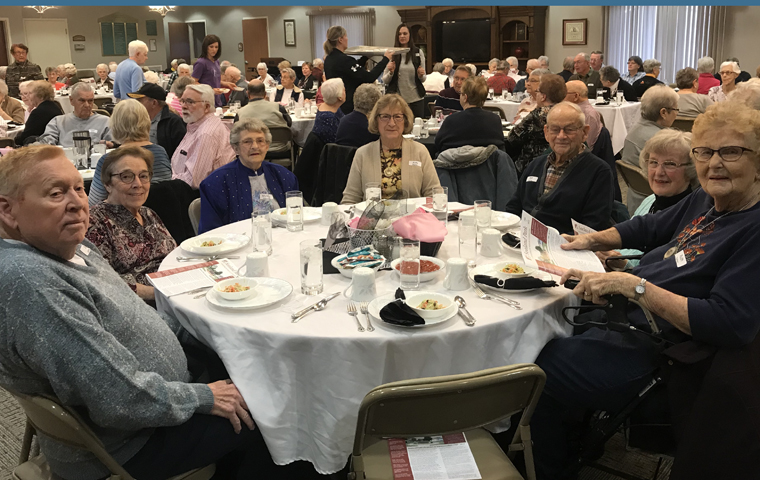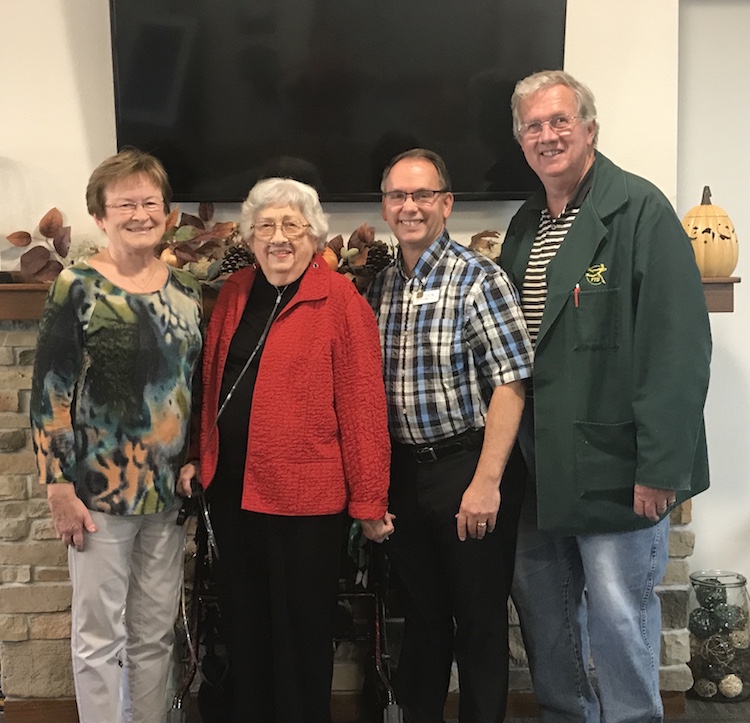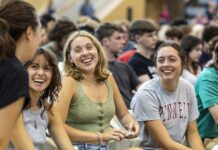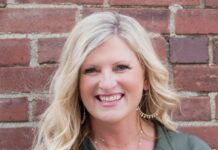

(Grinnell, IA – November 6, 2019) Seeland Park, an active 55+ Life Plan Community located on the east side of Grinnell, recently celebrated its 30th Anniversary on October 30th. Following a special dinner for residents featuring top sirloin steak and breaded shrimp prepared by St. Francis Manor’s culinary staff, Executive Administrator/Manager Dion Schrack recognized three of the first elected Seeland Park Board members including Glenyce Conway, Rhea Light and Jim White. Dion also recognized 28 current residents who helped to develop the Seeland Park campus by building a home, including Ruth Palmer who has lived in her Phase I home for 26 years.
“I am so grateful for the 434 prior residents and the 197 current residents who have invested approximately $19 million to develop Seeland Park into the wonderful community it is today,” said Dion. Between 1989 and 2019, a total of 145 independent living residences have been built during six different building phases on what has now become a 31-acre campus. Each building phase represents a particular parcel of land acquired to accommodate the needs of new residents wishing to design and build a home in a life plan community. Unlike typical housing developments where homes are designed and built by a contractor and then sold, every residence at Seeland Park was contracted for and designed by an individual or couple before construction began.
At the celebration dinner, residents received a 30th Anniversary Special Edition history newsletter prepared by Administrative Assistants June Watkins and Shelley Schrack based upon a review of minutes from St. Francis Manor Board Meetings since 1987 and an interview of Dion Schrack who has been St. Francis Manor’s Administrator since 1982. Board minutes noted that in August of 1987, Grinnell General Hospital had announced plans to sell the cleared land where St. Francis Hospital had once stood to an out-of-town low-income housing developer. After the developer was unable to obtain financing, St. Francis Manor purchased the hospital land on July 1, 1988.
In early 1989, after Dion and several board members traveled to Mount Pleasant to tour independent living duplex units at Mapleleaf Village, the Board approved purchasing their basic floor plan with room dimensions and hiring Grinnell College Architect/ Engineer Dale Hawn to map out Phase I. The Board also discussed two names for the community: “Penrose Park” based upon location, and “Seeland Park” after St. Francis Manor Board member and Grinnell College graduate Dick Seeland. Between July 1989 and May 1994, a total of 32 homes with approximately 1,250 sq. ft. of living space (16 small duplexes) were built in Phase I. The very first residents of Seeland Park were Ray and Doris Powell who moved into 906 Penrose on November 15, 1989 followed by Noel and Margaret Taylor at 908 Penrose on December 7, 1989.
In December of 1992, St. Francis Manor purchased 4.53 acres south of the Manor from Margaret Brink for Seeland Park’s Phase II development. Due to a growing demand for larger homes, the first Phase II duplex built in 1994 included a 1,750 sq. ft. unit and a 2,000 sq. ft. unit located at 2002 & 2004 Fourth Avenue. During 1995 and 1996, 24 homes (6 large duplexes and 6 small duplexes) were built in approximately 24 months!
In July 1994, Bill Weeks’ property southwest of the Manor on 2nd Avenue became available so St. Francis Manor purchased 2.75 acres from Bill. This land, which was not developed until 10 years later in 2004, is now known as Phase V and includes 6 homes (1 large duplex and 4 single-family homes).
As Seeland Park continued to grow, the Board recognized a need for a larger space to accommodate community dinners and other events and began construction of a 3,000 sq. ft. social center and four apartments (4-Plex) on the northwest side of St. Francis Manor in late 1995. Seeland Park residents enjoyed their first Christmas party in 1996 in the Social Center, which continues to be a huge blessing to the community as it brings residents and families together.
In February 1996, St. Francis Manor acquired 4.5 acres southwest of the Manor from the Estates of Nettie and Mary Hazel Lincoln for Seeland Park’s Phase III development which now has 24 homes (4 small duplexes and 8 large duplexes).
Construction to build a duplex with two 1-bedroom units and eight independent living apartments (8-Plex) on the north side of St. Francis Manor began in 1998. The following year, St. Francis Manor purchased three acres directly east of the Manor from James Lang for purposes of building another duplex with 1-bedroom units and ten more apartments (10-Plex) with garages and a common area (now known as the Hawn Center). Several years later, a single-family home was also built on this property.
In 1999, another five acres southeast of the Manor were purchased from Mildred Cogley for Seeland Park’s Phase IV development which includes 22 homes (2 small duplexes, 8 large duplexes and 2 single-family homes). In 2009, a rental house that was still located on the Phase II land was moved off of the property and the land was excavated for future development of a single-family home which was subsequently built in April 2012. Also during 2012, four 8-Plex garages were remodeled to accommodate Seeland Park’s first two-bedroom apartment with an attached garage.
In July 2014, St. Francis Manor purchased four acres from Bill Tish to develop building lots for 13 single-family homes or large duplexes. Since then, 8 single-family homes have been built in Phase VI, leaving 5 lots available for future construction.
Seeland Park continues to meet the changing needs or wants of the residents it serves, from remodeling or upgrading existing homes to building larger and more customized homes. A wide variety of affordable independent living homes now exist, including 772 sq. ft. apartments attached to the Manor; 950 to 1,050 sq. ft. one-bedroom duplexes; 1,250 to 2,000 sq. ft. two-bedroom duplexes; and single-family homes with 2 or 3-car garages and an optional basement.
Thanks to progressive board members and Dion Schrack’s vision and caring leadership, Seeland Park has grown from just 4 independent living residences in 1989 to 145 residences on a 31-acre campus in 2019. In addition to providing its residents with maintenance-free living, Seeland Park offers a variety of activities, events and fitness classes to engage campus residents physically, mentally and socially. For more information on Seeland Park, please visit www.seelandpark.com.





